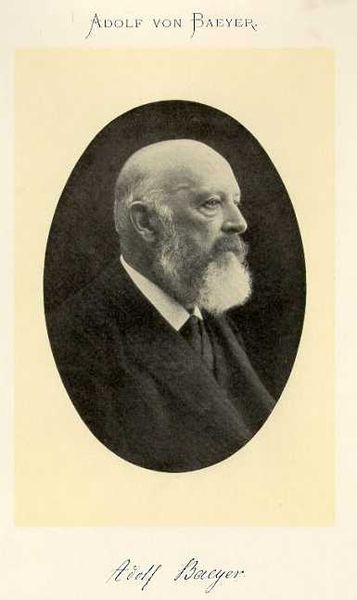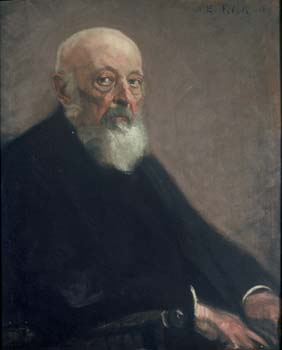<Back to Index>
- Chemist Johann Friedrich Wilhelm Adolf von Baeyer, 1835
- Painter Henri Regnault, 1843
- King of Portugal and the Algarves Edward, the Philosopher, 1391
PAGE SPONSOR


Johann Friedrich Wilhelm Adolf von Baeyer (October 31, 1835 - August 20, 1917) was a German chemist who synthesized indigo, and was the 1905 recipient of the Nobel Prize in Chemistry. Born in Berlin, he initially studied mathematics and physics at Berlin University before moving to Heidelberg to study chemistry with Robert Bunsen. There he worked primarily in August Kekulé's laboratory, earning his doctorate (from Berlin) in 1858. He followed Kekulé to the University of Ghent, when Kekulé became professor there. He became a lecturer at the Berlin Trade Academy in 1860, and a Professor at the University of Strasbourg in 1871. In 1875 he succeeded Justus von Liebig as Chemistry Professor at the University of Munich.
Baeyer's chief achievements include the synthesis and description of the plant dye indigo, the discovery of the phthalein dyes, and the investigation of polyacetylenes, oxonium salts, nitroso compounds (1869) and uric acid derivatives (1860 and onwards) (including the discovery of barbituric acid (1864), the parent compound of the barbiturates). He was the first to propose the correct formula for indole in 1869, after publishing the first synthesis three years earlier. His contributions to theoretical chemistry include the 'strain' (Spannung) theory of triple bonds and strain theory in small carbon rings.
In 1871 he discovered the synthesis of phenolphthalein by condensation of phthalic anhydride with two equivalents of phenol under acidic conditions (hence the name). That same year he was the first to obtain synthetic fluorescein, a fluorophore pigment which is frequently referred to as pyoverdin when naturally synthesized by microorganisms (e.g., by some fluorescent strains of Pseudomonas). Von Baeyer named his finding resorcinphthalein as he had synthesized it from phthalic anhydride and resorcinol. The term fluorescein would not start to be used until 1878.
In 1872 he experimented with phenol and formaldehyde, almost preempting Leo Baekeland's later discovery of Bakelite.
In 1881 the Royal Society of London awarded Baeyer the Davy Medal for his work with indigo. He was elected a Foreign Honorary Member of the American Academy of Arts and Sciences in 1884. In 1905 he was awarded the Nobel Prize in Chemistry "in recognition of his services in the advancement of organic chemistry and the chemical industry, through his work on organic dyes and hydroaromatic compounds".
Baeyer's name is pronounced like the English word "buyer." His birth name was Johann Friedrich Wilhelm Adolf Baeyer, but throughout most of his life he was known simply as "Adolf Baeyer." On his fiftieth birthday he was raised to the hereditary nobility, changing his name to "Adolf von Baeyer."